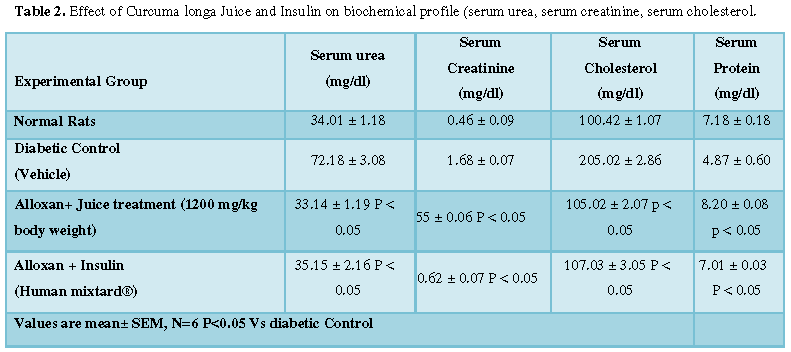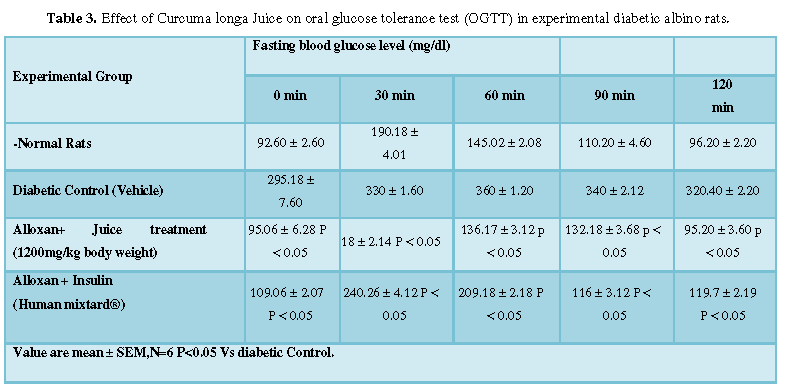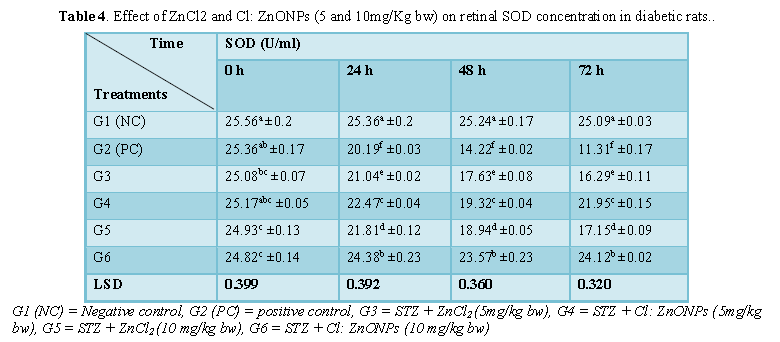Research Article
Therapeutic Effect of Turmeric (Curcuma longa Linn.) Rhizome Fresh Root Juice in Alloxan Monohydrate Induced Type-1 Diabetes in Albino Rats
5091
Views & Citations4091
Likes & Shares
From time immemorial therapeutic potential of Curcuma longa is known. In present study an effort has been made to assess the hypoglycemic, anticholesterolmic, anti-ureatic, anti-creatinic and oral glucose tolerance test (OGTT) activity of Curcuma longa juice in alloxan monohydrate induced experimental animal model. Rats were acclimatized for 7 days in lab temperature. All animals were given standard water and pellet diet. Diabetes was induced in rats with the help of alloxan monohydrate (130 mg/kg body weight). After alloxan monohydrate injection rats were separated and treatment started with Curcuma longa juice and insulin. A marked rise in fasting blood glucose, serum cholesterol, serum creatinine, serum urea level was observed in diabetic control rats when compared to normal control rats. Anti- hyperglycemic, anti-cholesterolmic, anti-creatinic, anti-ureatic activity observed in Curcuma longa fresh root juice administered rats on 15th, 30th, 45th and 60th days post treatment. Anti-hyperglycemic, anti-cholesterolmic, anti-ureatic, anti-cratinic activity was found almost similar effect like insulin treatment group. It is hope that present investigation will be helpful in establishing a scientific basis for antidiabetic, anti-cholesterolmic, anti-creatinic, anti-ureatic effects in experimental animal model. The results are (<0.05) statistically significant.
Keywords: Diabetes, Blood glucose, Insulin, Curcuma longa, Serum, Urea, Creatinin
INTRODUCTION
Incidence of diabetes mellitus in India will increasing at war foot lavels. The disease affecting both rural and urban population at an alarming rate. Diabetes are a potentially devastating disease with high morbidity and mortality. The central identifying feature of diabetes is chronic and substantial elevation of the circulating glucose level and the underlying goal of all diabetes treatment and management are to maintain an optimum blood glucose level [1].
During the year 2019, India had 72.96 million people suffering from diabetes and after eleven years total number of diabetes has to be 98 million. Several oral and injectable anti-diabetic drugs are used in treatment of diabetes. The existing group of oral hypoglycemic drugs includes Sulphonylures, Biguanide alpha-glucosidase inhibitor, glucagon like peptide analogs, Dipeptidyl peptidase -4 inhibitors, PPAR-𝛾 agonist etc are in use. Recently SGLT 2 inhibitors (in kidney), Aldolase reductase inhibitors, agonists of fibroblast growth factors -21(FGF-21) are being explored. Several side effects associated with the use of such oral or injectable hypoglycemic agent during or after treatment have been reported [2,3]. But no any side effect associated with the use of herbal drugs [4,5]. There is growing interest in herbal remedies for diabetes, due to their availability and lesser side effects. Gradually increasing order of this disease effect, the society, for that medical sciences is busy to search some positive technology by which this abnormality can be deleted [6].
Dietary agents such as spices have been used extensively in the Eastern world for a variety of ailments for millennia, and five centuries ago, they took a golden journey to the Western world. Various spice- derived neutraceuticals including 1-acetoxychavicol acetate, anethole, capsaicin, cardamonin, Curcumin, dibenzoylethane, diosgenine, eugenol, gambogicacid, gingerol, thymoquinone, ursoliccid, xanthohumol and zerumbone derived from galangal, anise, red chili, black cardamom, turmeric, licorice, fenugreek, clove, kokum, ginger, black cumin, rosemary, hop and panecone ginger have been investigated. Although, they always been used to improve to taste and color and as a preservative, they are also used in the treatment of Diabetes Mellitus, but none of them could be developed as a drug for diabetics.
Curcuma longa L. (Zingiberaceae), commonly known as turmeric, is native to Southwest India .Curcuma longa generally used in treament of indigestion, cough, arthritis, diabetes, blood purifier, menstrual irregularities [7] and antioxidant [8,9]. Present investigation was conducted to evaluate the anti-diabetic, anti-cholesterolmic, anti-ureatic and anti-creatinic properties in alloxan monohydrate administered animals’ model.
Objective
To gain a scientific understanding of Turmeric roots therapeutic values and their efficacy in the treatment and management of the disease, diabetes.
MATERIALS & METHODS
Plant materials
The Turmeric (Curcuma longa Linn.) used for present investigation. Turmeric fresh root was obtained from the local crop field of Darbhanga, India.
Juice of Curcuma longa
Firstly, Curcuma longa root was procured from crop field area and was cleaned and extracted the juice. Juice was administered with the help of intubation tube.
Male albino rats (200-250g and 10-14 weeks) were used as experimental animals. Animals were procured from local supplier of Darbhanga, India.
The rats were acclimatized for 7 days. All the animals were fed with rodent pellet diet Water was allowed ad-libitum under strict hygienic condition.
Induction of diabetes
Alloxan Monohydrate is a toxic glucose analogue which selectively destroys insulin producing cell in pancreas. This causes insulin dependent diabetes mellitus called “Alloxan Diabetes” [4]. Alloxan monohydrate was obtained from Explicit Chemicals Pvt. Ltd, Pune, India.
Experimental design
- Normal Control
- Diabetic control
- Alloxan +Curcuma longa Juice treatment
- Alloxan+Insulin treatment
The diabetes was induced in 12 h fasted animal by a single intraperitoneal injection of freshly prepared solution of Alloxan monohydrate (135 mg/kg body weight) in 0.5ml normal saline water.
After 72 h of Alloxan monohydrate injection, the diabetic rats (blood glucose levels<290mg/dl) were separated. Treatment was started except in normal control and diabetic control animals. During further investigation all experimental group animals were given standard hygienic water and pellet diet. Blood glucose were monitored with the help of digital glucometer (Dr. MorepenGluco One).
RESULTS & DISCUSSION
A significant increase in fasting blood glucose levels was measured in diabetic control (vehicle) when compared to normal rats. Anti- diabetic, anticholesterolmic, anti-ureatic, anti-creatinic activity was recorded in Curcuma longa juice treated rats on 15th, 30th, 45th and 60th day post treatment. The serum cholesterol, serum urea and serum creatinine of diabetic control animals were higher than the other experimental group. Anticholesterolmic, anti-ureatic, and anti-creatinic activity were recorded in juice and insulin administered animals. Oral glucose tolerance test was significantly tolerated administered glucose in juice treated animals compared to diabetic control group. Turmeric also improves the serum protein count when compared to diabetic control rats. The results are shown in Tables 1, 2 and 3.










Curcuma longa fresh root juice was found almost similar effect like insulin treatment group. The result of the present investigation indicates that Curcuma longa fresh root juice have the property to lowers the blood glucose, serum creatinine and serum urea levels. Alloxan monohydrate facilitates the production of free radicals and causes the tissue damage. The beta cells of pancreas are susceptible to such damage. It appears from the present investigation that the Curcuma longa fresh root juice might have tissue repairable and restorative capacities [10]. Research has also reported beet root juice treated rat showed reduction of blood glucose in alloxan monohydrate induced diabetic rats. Finding in this regard with Curcuma longa fresh root juice and beet root juice was also no different [11]. Research has reported that oral administration of aqueous extract of Curcuma longa root lead to marked lowering of blood glucose level in alloxan induced experimental model [12]. Scientists have also demonstrated that crude aqueous extract of Curcuma longa fresh root possess hypoglycemic properties in Alloxan administered animal model. Findings in the present study too are in accord with the findings discussed above; Curcuma longa fresh root juice has been widely used for curing various maladies. Present investigation will be helpful in establishing a scientific basis for anti-diabetic, anti-cholesteromic, anti-ureatic, anti-creatinic uses of Curcuma longa fresh root juice in alloxan induced experimental animal model. Curcuma longa fresh root juice tolerated the overdose of glucose through oral glucose tolerance test in juice treated experimental animals. However, much more studies are still required to explore the other potential of this fresh plant root.
From the present investigation it is appeared that Curcumalonga fresh root juice might have some ingredients to increase the output of insulin by binding to the receptors of the beta cells of the Langerhans located in the pancreas. Once they bind to the sulphonylureas receptors, the K+-ATP channels are probably closed and therefore the membrane is depolarized, and insulin production is stimulated.
However, there is a dearth of literature related to the effect of turmeric in experimental animal model especially those related to diabetes.
CONCLUSIONS
It is hoped that present investigation will provide significant alternative therapies to diabetics. This therapy is not only to control blood glucose level but also account for all over improvement in the experimentally induced diabetic rats’ condition.
This research appears that turmeric (Curcuma longa) works as anti-diabetic agent. So, this plant root will be helpful in treating the diabetes in rural Asian countries due to low cost, easily availability and no any side effects associated with the use of this plant root.
ACKNOWLEDGEMENT
The authors are thankful to Head, University Department of Zoology, L.N.Mithila University Darbhanga, India for the lab facilities provided. The authors are also thankful to Mr. Dinesh Munot Explicit Chemical Pvt. Ltd. Pune for providing free sample of Alloxan monohydrate for the present investigation. The authors are also thankful to Dr. N.K. Dubey, Former Dean Faculty of Science, L.N. Mithila University Darbhanga, India, Dr. Usha Dubey, Head Department of Zoology, NJM College Laheriasarai, L.N.Mithila University Darbhangalndia, Dr. R.P.Sinha, Retd Professor, Department of Zoology, C.M. Science college ,L.N.Mithila University Darbhanga India for their kind co-operation during present investigation.
- Kumar S, Shachi K., Kush K, Dubey NK (2012) Antidiabetic and hematinic effects of Trigonellafoenum-graecum fenugreek in alloxan induced diabetic albino rats. J Zool 32: 249-251.
- Monami M, Lamanna C, Ralzi D, Marchionni N, Mannucci N, et al. (2009) Sulphonylureas and cancer a case control study. ActaDiabetol 46: 279-284.
- Samantha LB, Submit BM, Paul V, Jeffery J (2006) Increased cancer related mortality for patients with Type-2 diabetes who use Sulphonylureas or insulin. Diabetes Care 29: 254-258.
- Lenzen S (2008) The mechanism of alloxan and streptozotocin induced diabetes. Diabetologia 51:194-198.
- Sarvanan G, Leelavinothan P (2006) Effect of Syzygiumcumini Bark on blood glucose, plasma insulin and C-peptide in streptozotocin induced diabetic rats. Int J EndocrinolMetab 4: 96-105.
- Kumar S, Shachi K (2020) Therapeutic Efficacy of Azadirachtaindica leaves in Alloxan Monohydrate induced type-1 diabetes in albino rats. EC Diabetes and Metabolic Research 4: 1-4.
- Sawant RS, Godghate AG (2013) Qualitative and quantitative screening of rhizomes Curcuma longa linn.Int J SciEnvirontTechnol 4:634-641.
- Hanninen O, Rauma AL, Kaartinen K, Nenonen M (1999) Vegan diet in physiological health promotion. ActaPhysiol Hung 86(34): 171-180.
- Latif J, Mukhtar S, Qamar I (2017) Hypoglycemic effect of turmeric in alloxan-induced diabetic rats. Ann King Edw Med Univ 23(3).
- Kumar S, Shachi K, Dubey NK, Dubey U (2020) Anti-diabetic and haematinic effects of beet root juice (Beta vulgaris L.) in Alloxan Induced Type-1 Diabetic Albino Rats. J Diab Res Ther 6(1).
- Olatunde A, Joel EB, Tijjani H, Obidola SM, Luka CD (2014) Anti-diabetic activity of aqueous extract of Curcuma longa Linn rhizome in normal and alloxan-induced diabetic rats. Res 6: 58-65.
- Mohammad A, Wudi AM, Alhassan AJ, Imam AA, Muhammad I, et al. (2017) Hypoglycemic activity of Curcuma longa Linn Root extracts on Alloxan induced diabetic rats. Saudi J Biol Sci 2: 43-49.
QUICK LINKS
- SUBMIT MANUSCRIPT
- RECOMMEND THE JOURNAL
-
SUBSCRIBE FOR ALERTS
RELATED JOURNALS
- Advance Research on Alzheimers and Parkinsons Disease
- Journal of Pathology and Toxicology Research
- Advance Research on Endocrinology and Metabolism (ISSN: 2689-8209)
- Archive of Obstetrics Gynecology and Reproductive Medicine (ISSN:2640-2297)
- Journal of Oral Health and Dentistry (ISSN: 2638-499X)
- Journal of Ageing and Restorative Medicine (ISSN:2637-7403)
- Journal of Otolaryngology and Neurotology Research(ISSN:2641-6956)


